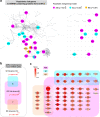Roles and mechanisms of ankyrin-G in neuropsychiatric disorders
- PMID: 35794211
- PMCID: PMC9356056
- DOI: 10.1038/s12276-022-00798-w
Roles and mechanisms of ankyrin-G in neuropsychiatric disorders
Abstract
Ankyrin proteins act as molecular scaffolds and play an essential role in regulating cellular functions. Recent evidence has implicated the ANK3 gene, encoding ankyrin-G, in bipolar disorder (BD), schizophrenia (SZ), and autism spectrum disorder (ASD). Within neurons, ankyrin-G plays an important role in localizing proteins to the axon initial segment and nodes of Ranvier or to the dendritic shaft and spines. In this review, we describe the expression patterns of ankyrin-G isoforms, which vary according to the stage of brain development, and consider their functional differences. Furthermore, we discuss how posttranslational modifications of ankyrin-G affect its protein expression, interactions, and subcellular localization. Understanding these mechanisms leads us to elucidate potential pathways of pathogenesis in neurodevelopmental and psychiatric disorders, including BD, SZ, and ASD, which are caused by rare pathogenic mutations or changes in the expression levels of ankyrin-G in the brain.
© 2022. The Author(s).
Conflict of interest statement
The authors declare no competing interests.
Figures





